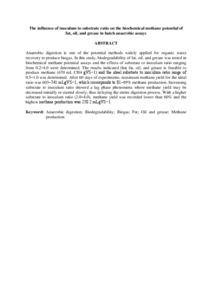Citation
R., Naizatulshila and Idris, Azni and Harun, Mohd Razif and Wan Ab. Karim Ghani, Wan Azlina
(2015)
The influence of inoculum to substrate ratio on the biochemical methane potential of fat, oil, and grease in batch anaerobic assays.
Energy Sources Part A-Recovery Utilization and Environmental Effects, 37 (6).
pp. 590-597.
ISSN 1556-7036; ESSN: 1556-7230
Abstract
Anaerobic digestion is one of the potential methods widely applied for organic waste recovery to produce biogas. In this study, biodegradability of fat, oil, and grease was tested in biochemical methane potential assays and the effects of substrate to inoculum ratio ranging from 0.2–4.0 were determined. The results indicated that fat, oil, and grease is feasible to produce methane (670 mL CH4 gVS−1) and the ideal substrate to inoculum ratio range of 0.5–1.0 was determined. After 60 days of experiments, maximum methane yield for the ideal ratio was 603–741 mLgVS−1, which corresponds to 81–89% methane production. Increasing substrate to inoculum ratio showed a lag phase phenomena where methane yield may be decreased initially or started slowly, thus delaying the entire digestion process. With a higher substrate to inoculum ratio (2.0–4.0), methane yield was recorded lower than 60% and the highest methane production was 250.2 mLgVS−1.
Download File
![[img]](http://psasir.upm.edu.my/46635/1.hassmallThumbnailVersion/The%20influence%20of%20inoculum%20to%20substrate%20ratio%20on%20the%20biochemical%20methane%20potential%20of%20fat%2C%20oil%2C%20and%20grease%20in%20batch%20anaerobic%20assays.pdf)  Preview |
|
Text (Abstract)
The influence of inoculum to substrate ratio on the biochemical methane potential of fat, oil, and grease in batch anaerobic assays.pdf
Download (104kB)
| Preview
|
|
Additional Metadata
Actions (login required)
 |
View Item |

